Cambridge Chiropody & Podiatry Ltd
11 Cook Close, Cambridge CB4 1PH
Telephone 01223 322636

Chiropody - Common Conditions
We treat and give advice on foot pathologies such as: Callous, Corns, Verrucae and nail problems.
- Callouses and Corns
- Fungal Infection - Mycosis
- Hammer Toe
- Mallet Toe
- Ingrowing Toenail (Onychocryptois)
- Gross thickening of nails (Onychogryphosis)
- General thickening of nails (Onycauxis)
- Verrucae
‘Images taken with permission from Dawber, Bristow and Mooney. (1996) The Foot: problems in podiatry and dermatology. London. Taylor Francis Ltd.’
Callouses and Corns


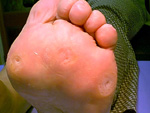
Signs and Symptoms
Corns and callus are due to excessive friction and pressure being placed on the skin, and they can occur on any area of the foot where pressure is applied. Over time the hard skin formation thickens to such an extent that it presses down onto the sensory nerve endings giving rise to pain. The excessive pressure can result from ill-fitting or tight footwear or deformities such as hammer toes or bunions, in which the foot takes up extra space in the shoe.
Treatment
To help prevent the formation of callouses and corns try to wear a style of shoe that does not apply pressure to vulnerable parts. Keep the skin supple with the application of a good quality foot moisturiser. Chiropody treatment comprises of gentle debridement of callous and enucleation of corns together with protective padding and various protective appliances and insoles. Avoid using medicated corn plasters and corn solvents as these often contain salicylic acid and will burn the ordinary surrounding skin.
Fungal Infection - Mycosis

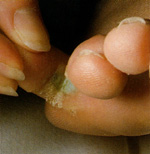
Signs and Symptoms
Fungal spores reside often between the toe causing the skin to itch and become sore - the area often becomes red raw with white peeling skin on the periphery.
Treatment
Many antifungal creams are available from your local pharmacist. Remember that over treatment is desirable to make sure complete eradication of fungal spores. Prevention wear flip flop sandals in showers etc plus the application of antifungal sprays.
Hammer Toe
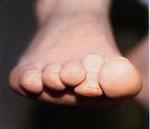

Signs and Symptoms
This is where the toe (often 2nd; 3rd or 4th toe) is bent at the proximal joint. There is often the formation of corns over the joint and end of toe.
Treatment
(i) Protection of the end of the toe and on the promanant joint on the top. (ii) Removal of corns. (iii) Surgical correction.
Mallet Toe
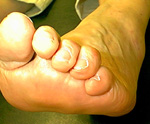
Signs and Symptoms
This is where the toe is bent at the distal most joint of the toe.
Treatment
Similar to the hammer toe –
(i) Removal of corns from the prominent joint or the tip of the toe.
(ii) Protective padding or appliance.
(iii) Surgical correction may be necessary.
Ingrowing Toenail (Onychocryptois)


Signs and Symptoms
A true ingrown toenail is where the side of the toenail pierces the flesh and then lies in the cut and prevents it from healing. Often it becomes infected and excessive tissue (hypergranulation tissue) begins to form around the edge of the nail.
Treatment
Conservative treatments involve removal of the offending part of the nail followed by periodic prevention treatments.In cases where the condition is very chronic or when regular repetitive episodes occur then minor nail surgery is often indicated.
Gross thickening of nails (Onychogryphosis)


Signs and Symptoms
Grossly thickened nail often associated with the history of sudden trauma. May be painful from shoe pressure, often leading to ulceration of the nail bed.
Treatment
Radical cutting away and reduction of the nail plate - surprisingly painless.
General thickening of nails (Onycauxis)

Signs and Symptoms
A general thickening of the nail. Sometimes painful due to pressure from the shoe.
Treatment
Gentle thinning of the nail plate
Verrucae
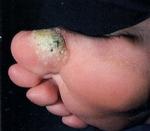
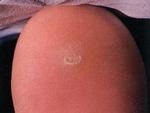
Signs and Symptoms
A verruca is a viral infection in the superficial layers of the skin. Verrucae can appear anywhere on the feet and vary considerably in their size and the number of them present at any one time. Verrucae appear very similar to corns but can often be distinguished due to the black dots that appear in the centre of them (tiny blood vessels).
Treatment
If a verruca is not painful it can be left untreated as over time they can resolve themselves, however if they are causing pain when walking or spreading across the feet then it is advisable to treat them.
Unfortunately there is no guaranteed cure for verrucae, but they often respond to treatment by caustics, Salicylic acid and Cryotherapy (freezing with liquid nitrogen). Verrucae very rarely disappear after just one treatment, and a course of treatments is recommended usually with 2-4 week gaps between treatments. The course can vary from as little as two treatments to considerably more, depending on the severity of the verruca and the length of time it has been present. However the Podiatrist will review the effectiveness and the patient’s reaction of each treatment and vary the choice of substance used accordingly.
Liquid nitrogen is the strongest of the three treatments offered in our clinic but is also the most painful, and the patient must be aware that the foot may remain sore for a couple of days after the treatment as the skin over the verruca may blister. The Podiatrist will do their best to pad around the verruca to redistribute any pressure of the area to make the foot comfortable to walk on, but it is advisable to rest the foot as much as possible immediately after the treatment.